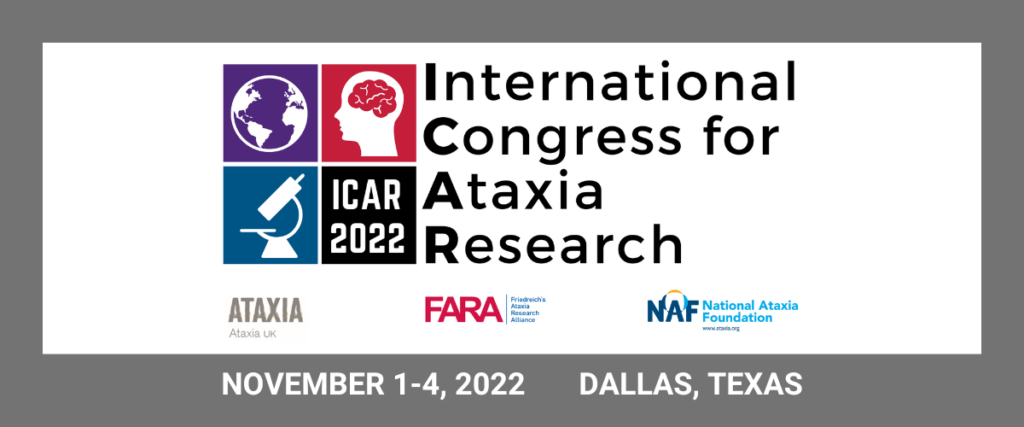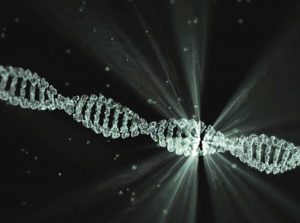
Written by Dr. Jorge Diogo Da Silva, with notes from Sarah Donofrio and Celeste Suart
Edited by Hayley McLoughlin
From drugs and gene therapy, to electrical current and exercise programs: how researchers are becoming more innovative in the search for new treatments, in the lab models to test them, and in how to measure their efficiency in patients.
After two full days of exciting sessions and social networking, the first session of day 3 in the ICAR was dedicated to one of the hottest topics in ataxia research: emerging and existing therapies. The keynote talk, by Dr. Beverly Davidson (The Children’s Hospital of Philadelphia), was focused on therapies for spinocerebellar ataxia type 1 (SCA1) and novel tools for controlled CRISPR editing. Toward the SCA1 gene therapy approach, she detailed findings from her recent Nature Medicine article, highlighting the need for extended safety studies in multiple animal models prior to treatment. Also addressing some of the concerns of viral gene therapy, she also provided an exciting overview of their revolutionary new tool called Xon, that regulates gene therapy expression with a drug (published in Nature). This new approach is broadly applicable and will likely result in less unintended editing of the genome and lower immune response.
Dr. Gilles Naeije (Université Libre de Bruxelles) presented results from a clinical trial for Friedreich’s ataxia (FRDA), where his group tested a technology named “cerebellar transcranial direct current simulation” (tCDS). tCDS uses a device that is placed near one of the brain regions that regulates movement and emits an electrical current to increase cell’s activity. This type of electrical current after 5 days of treatment improved SARA score by 7% and improved some cognitive symptoms in a cohort of 25 patients with FRDA. The group is now hoping to understand which types of FRDA patients would benefit more from tCDS.
Dr. Nancy Levin (Design Therapeutics) presented their work toward a new drug (DT-216) that has been designed for treatment of FRDA. Since FRDA is caused by a decrease in the frataxin protein, this new drug was able to normalize its production in cells, making them healthier. While the efficacy of this drug has not been tested in animal models of FRDA (such as mice), it has promising effects.
Shifting from FRDA to spinocerebellar ataxia type 3 (SCA3)/Machado-Joseph disease (MJD), Dr. Patrícia Maciel (University of Minho) presented a new drug (called CLR01) for the treatment of SCA3. The brain of SCA3 patients has accumulation of protein aggregates that block the function of neurons, just like large boulders blocking a road. This new drug functions as a tweezer that picks and removes these aggregates/”boulders”, restoring “traffic” in the brain. In a mouse model of SCA3, CLR01 treatment was able to delay the onset of disease, however the motor rescue was not sustained overtime.
The last session focused on autosomal recessive spastic ataxia of Charlevoix-Saguenay (ARSACS). Dr. Andrea Del Bondio (San Raffaele Scientific Institute) showed how Purkinje cells, one of the most important type of cells in the cerebellum, are affected in ARSACS. He observed that calcium inside those cells was abnormally distributed. Afterwards, he showed that those changes could be tackled by an antibiotic drug called ceftriaxone. This drug was also able to improve motor skills in mice with ARSACS.
After the start of the day, attendees of the ICAR could now choose between three breakout sessions.
The first was the “Cell and Animal Models” breakout session. This session highlighted the importance of having laboratory models that show the same changes and symptoms as patients, makes them highly “realistic simulators” for treatment testing. In this session there were eight interesting presentations that tackled new models for FRDA, SCA1, SCA3, SCA48 and fragile X-associated tremor/ataxia syndrome (FXTAS). The new and innovative models ranged from cells derived from patients, to microscopic worms and mouse models. One of the most prominent topics in this set of talks was the characterization of patient-derived cells to study FRDA. Since FRDA can affect both the brain and the heart, researchers showed they could grow brain cells and heart cells derived from patients’ skin cells. All in all, this session provided updates toward many new lab models are available for researchers to use in the pursuit of new treatments.
The second parallel breakout session focused on “Clinical Outcome Assessments and Natural History Studies”. The “clinical outcome assessment” refers to techniques in which doctors evaluate if the patient is doing better/worse after trying a certain treatment. The “natural history studies” involve following a patient for several years, to see how the disease progresses without intervention. While it may seem contradictory, knowing the natural history of a disease is very important, as researchers will know if a treatment is changing the course of the disease or not. Out of the eight sessions, we saw several that used smartphones/tablets to track FRDA symptoms in a continuous manner. This allows researchers to be more precise in evaluating the condition of a patient. Another focus point of the talks was the discovery of clinical measures that are meaningful to patients. Researchers are asking patient to report that if they are feeling better in addition to the clinical assessments. These scales have been tested in different SCAs and FRDA. This change towards a “patient-centered” approach to clinical trials is very important: we want to test if a treatment improves how the patient feels, more than how the scores of a motor test change.
Finally, the third parallel session was a workshop on the genetic diagnosis of ataxias. We have been focusing so far on research and treatments for ataxia. However, it is still a challenge for doctors in the clinic to appropriately treat an ataxic patient who still does not have a diagnosis. This workshop, led by Dr. Elisabetta Indelicato (Center for Rare Neurological Disorders Innsbruck) and Dr. Andrea Nemeth (University of Oxford), provided young doctors with practical tools to approach patients with ataxia. They showed which lab or genetic tests should be asked first in patients with different ages and symptoms. These techniques are surely to be very helpful to doctors that are new to treating patients with ataxia.
In conclusion, the Thursday Morning sessions Highlighted cutting-edge therapeutic research, characterization of novel model system, and several tools diagnose, track disease progression, and inform therapeutic effects.
About the Author and Editor
Jorge Diogo Silva is a member of the Maciel lab, at the University of Minho, Portugal. He studies neurodegenerative using Caenorhabditis elegans models. His supervisor Dr. Patrícia Maciel presented research in this session.
Dr. Hayley McLoughlin is an Assistant Professor in the University of Michigan Neurology Department, with a joint appointment in the Department of Human Genetics. Her lab currently focuses on establishing pathogenic mechanisms and therapeutic interventions for SCA3. She has no conflict of interest to declare regarding this session.

Snapshot: What is Articulation?
Articulation refers to the ability to produce speech sounds using the tongue, lips, jaw, and the roof of your mouth. All of these organs are also known as articulators. The Read More…


Interrupciones en las repeticiones están asociadas con ataques epilépticos en SCA10
Escrito por Dr Hannah ShorrockEditado por Larissa NitschkeTraducido por Ismael Araujo-Aliaga Interrupciones en las repeticiones en SCA10 influyen en la estabilidad del tramo repetido y están asociadas con ataques epilépticos Read More…


Snapshot: What is Resonance?
In speech-language pathology, the term resonance refers to nasality in speech. In other words, how nasal a person’s speech sounds. When someone is congested, they likely sound hyponasal, or not Read More…









